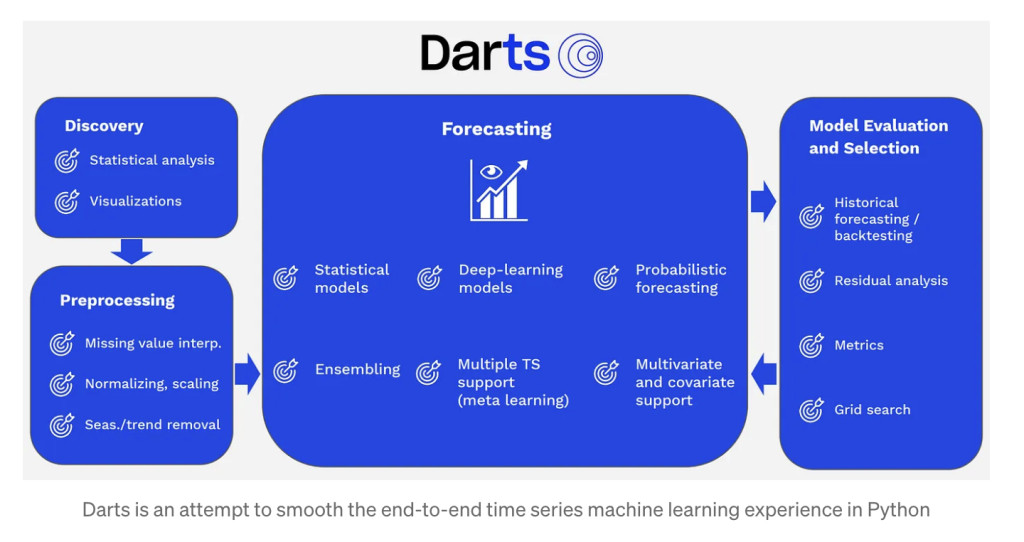Time series data, representing observations recorded sequentially over time, permeate various aspects of nature and business, from weather patterns and heartbeats to stock prices and production metrics. Efficiently processing and forecasting these data series can offer significant advantages, such as strategic business planning and anomaly detection in complex systems. However, despite the numerous models and tools available for time series analysis, their complexities and diverse APIs often present challenges to users. Recognizing these difficulties, Unit8 has developed and open-sourced a new tool called Darts, aimed at simplifying time series processing and forecasting in Python.
Data scientists working with time series data often find themselves navigating a fragmented landscape of tools. Typically, a different library is needed for each step: Pandas for preprocessing, statsmodels for seasonality detection, Facebook Prophet for forecasting, and custom scripts for backtesting and model selection. This disjointed workflow is not only tedious but also complicates the process of integrating more advanced models like neural networks, which may require libraries such as TensorFlow or PyTorch. These challenges underscore the need for a more streamlined, consistent, and user-friendly solution.
Darts is Python library that aims to be the scikit-learn for time series analysis. By providing a unified and consistent API, Darts simplifies the end-to-end process of working with time series data. It integrates various functionalities—data manipulation, model fitting, forecasting, and backtesting—into a single framework, making it easier for users to switch between models and approaches without dealing with compatibility issues.
At the core of Darts is the TimeSeries data type, designed to represent multivariate and potentially probabilistic time series. This format ensures that time series are well-formed with a proper time index and can handle multiple samples for probabilistic models. Users can easily convert Pandas DataFrames into TimeSeries objects, facilitating seamless integration with existing data workflows.
Darts mimics the scikit-learn model interface, where the fit() method is used for training models and the predict() method for making forecasts. This consistent interface allows users to experiment with different models, from traditional methods like Exponential Smoothing and Auto-ARIMA to advanced neural network-based models like RNNs and Transformers. The library supports both univariate and multivariate time series, and can generate deterministic or probabilistic forecasts.
For example, training an Exponential Smoothing model on a time series of air passenger data involves just a few lines of code. The trained model can then generate forecasts, which can be visualized along with the actual data. Darts also supports backtesting, enabling users to evaluate model performance by simulating real-time forecasting scenarios and comparing historical forecasts with actual outcomes.
Darts offers a wide range of built-in models, including Exponential Smoothing, (V)ARIMA, Facebook Prophet, and various deep learning models like RNNs, TCNs, and Transformers. These models can be easily interchanged and compared, thanks to the unified fit() and predict() interface. Additionally, Darts provides robust support for deep learning, allowing models to be trained on multiple time series and covariates, with the capability to leverage GPUs for large datasets.
The library includes tools for backtesting and model evaluation, such as the historical_forecasts() function, which generates forecasts for specified horizons and timestamps, and calculates error metrics like the Mean Absolute Percentage Error (MAPE). This functionality enables users to fine-tune models and assess their accuracy and reliability over time.
Darts also supports more advanced features like probabilistic filtering, grid search for hyperparameter tuning, and automatic model selection. Its design ensures that TimeSeries objects are immutable, promoting a functional programming style and reducing the risk of unintended side effects.
Darts addresses the inherent complexities of time series analysis by offering a comprehensive, unified framework that simplifies model training, forecasting, and evaluation. By integrating various functionalities into a single, consistent API, Darts enhances the user experience and boosts productivity, making it an invaluable tool for data scientists and analysts working with time series data. The ongoing development and open-source nature of Darts ensure that it will continue to evolve, incorporating new features and improvements driven by community contributions.
The post Darts:Â A New Python Library for User-Friendly Forecasting and Anomaly Detection on Time Series appeared first on MarkTechPost.
Source: Read MoreÂ

